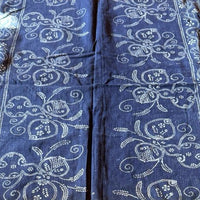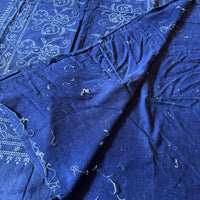A beautifully patterned antique futon-ji—the traditional cloth used as a futon cover in Japan—stitched from three handwoven panels of indigo-dyed cotton. The design features a phoenix-inspired arabesque: scrolling vines, stylized feathers, and dotted elements characteristic of katazome, a Japanese resist-dye technique where artisans used rice-paste stencils (katagami) to block the dye before immersion in natural indigo vats. Once the paste was rinsed away, the undyed motifs remained crisp against the deep blue ground, creating the elegant patterning you see here.
Three-panel futon-ji like this were typically sized to fit a single tatami mat (about 35" × 71"). In everyday life, bedding was aired outside, folded, and stored daily, so covers were made long and narrow for strength and ease of handling. Cloths like this lived at the heart of the household—used nightly, sun-dried each morning, and mended whenever needed.
This example shows the gentle character of age: softened indigo, light creasing, and tiny needle holes from long-ago seams. There are no major structural issues, and the textile retains excellent integrity for its age. The three full-width handwoven panels are machine-stitched together, with edges finished simply—typical of practical rural craftsmanship. It’s a versatile, history-rich piece ready for wall display, table use, upholstery accents, or thoughtful cutting for boro-style patchwork.
Age (approx. 1930–1945)
Based on the indigo tone, stencil style, panel construction, and sewing methods, this textile most likely dates to the late pre-war to early post-war Showa period (Showa era = 1926–1989). Its handwoven panels, natural-indigo dyeing, and practical machine-stitched seams all point to rural household production during the 1930–1945 range. While exact dating is not possible, these material traits are consistent with futon-ji made in that era.
Dimensions: 40.5" × 94.5" (103 × 240 cm)
Panels: 3 panels wide (each panel approx. 13.5–14" loom width before seam allowances)
Made in Japan




